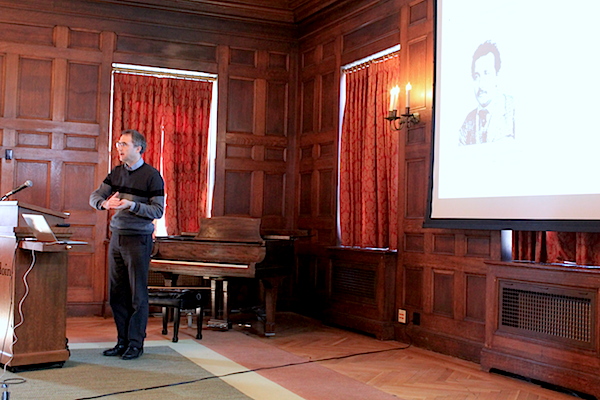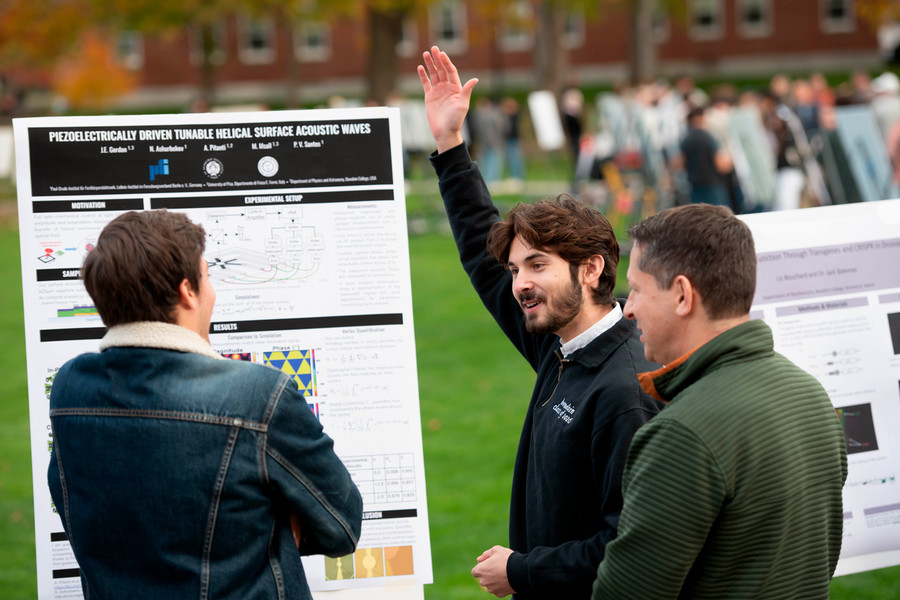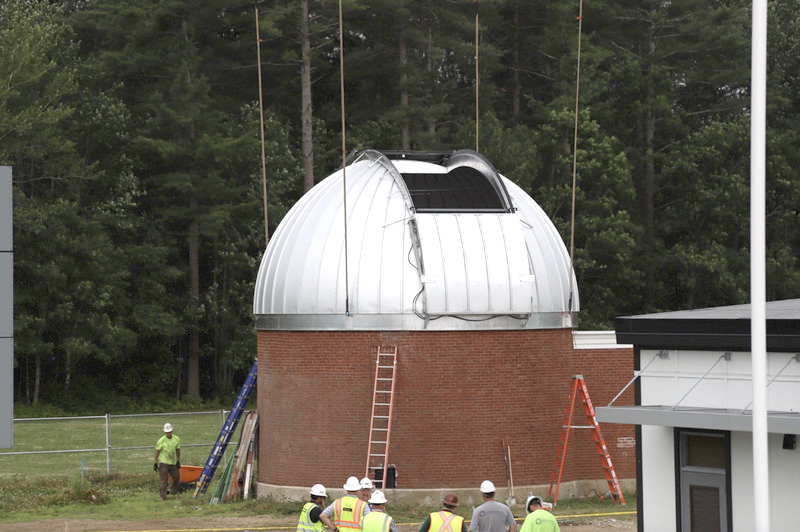Physics Professor Baumgarte Describes 100 Years of Gravity
By Rebecca Goldfine
This year is the 100th anniversary of general relativity, or more specifically, the 100th anniversary of the publication of a seminal paper that Albert Einstein wrote on the field equations of general relativity, which form the core of his relativistic theory of gravity.
In recognition of this anniversary, Thomas Baumgarte, a professor of physics and astronomy, spoke recently to an audience of Bowdoin faculty and staff about the history of our understanding of gravity. After offering this quick background, he touched on his own investigations in the field of numerical relativity.
Baumgarte began by discussing special relativity, which Einstein developed, 10 years earlier, in 1905, while he was employed as a patent officer in Bern, Switzerland. Special relativity is based on the observation that the speed of light is always the same, independently of who measures it, or how fast the source of the light is moving with respect to the observer. Einstein demonstrated that as an immediate consequence, space and time can no longer be independent, but should rather be considered a new joint entity called “spacetime.” But special relativity describes physics in the absence of gravity, whereas general relativity describes gravity in terms of the curvature of spacetime.
The first advances in our understanding of gravity were made by Galileo and Newton in the 16th and 17th centuries. At this point in his talk, Baumgarte slipped his hands into his pockets and pulled out two objects that happened to be there — his keys and a very old, hard marshmallow. He dropped these to the floor, which they hit at the same time, demonstrating Galileo’s observation that all objects, no matter their mass, fall at the same rate. Newton explained this phenomenon by positing that while the gravitational force acting on each body depends on its mass, the mass happens to cancel out when we compute the object’s acceleration.
More than two hundred years later, Einstein viewed this “coincidental cancellation as a smoking gun,” Baumgarte said. Einstein’s brilliant insight was that the rate of falling bodies was not affected by any intrinsic qualities they possessed, i.e. their mass, but rather by an intrinsic property of the spacetime through which the objects fell. This property is the curvature of spacetime. It determines the rate at which objects fall, and also makes light bend.
One of the first confirmations of general relativity was indeed based on the bending of light. British astrophysicist Sir Arthur Eddington and a team of collaborators traveled to Brazil and Africa in 1919 to watch a solar eclipse, giving them the opportunity to observe an apparent shift in the position of stars. “They traveled to two different locations in the southern hemisphere, observed the eclipse, observed the shifting of the stars, and came back to report that it was exactly as Einstein predicted,” Baumgarte said. “That is when general relativity became accepted.”
Baumgarte then explained that Einstein’s equations are so-called differential equations, which need to be solved before the solutions can make any predictions about nature. “Einstein gave us equations,” he said, “and it is up for us to find the solutions.” Since Einstein’s equations are quite complicated, it is difficult to solve these equations exactly and such exact solutions exist only under very special circumstances.
The first researcher to find an exact mathematical solution to Einstein’s equations was Karl Schwarzschild, who, at the time, was serving in the German army during WWI. Although Einstein’s equation is complex, and looks messy on the printed page, Schwarzschild “came up [in 1916] with a remarkably simple solution. Einstein was amazed,” Baumgarte said.
Baumgarte marveled, too, at Schwarzschild’s humanity, persistence and poeticism during wartime. In a letter he sent to Einstein, Schwarzschilde wrote, “As you see, the war treated me kindly enough, in spite of the heavy gunfire, to allow me to get away from it all and take this walk in the land of your ideas.”
However, Schwarzschild’s solution was considered astro-physically irrelevant for 50 years. It took another war, WWII, and the development of radio technology, to help astrophysicists discover high-energy objects in space. “These objects could only be explained by these extremely strong gravitational fields that are accounted for by general relativity — this was the first hint that black holes exist,” Baumgarte said. “Black holes [which have a singular spacetime curvature at their center] are solutions to Einstein’s equations.”
So, in the 1960s, the American theoretical physicist John Wheeler, who coined the term black hole, led a revival of Einstein’s findings. “It was the golden age of general relativity,” Baumgarte observed.
Despite the strangeness of black holes, Baumgarte said they can be described in remarkably simple terms. “We think of black holes as very exotic, very weird things,” Baumgarte said, “but in fact they are the only macroscopic object that we can describe exactly.”
Baumgarte then brought his talk to the present day and spoke about attempts by physicists to study binary black holes. These occur when two black holes move close to one another, orbiting each other until they finally merge. In this process, they cause spacetime to “wiggle a little,” he said. “That is a process we’re interested in because this process emits very strong gravitational radiation.”
Using laser interferometer gravitational wave observatories, scientists are hoping to measure this radiation “very soon, in the years to come.” This in turn will “open new windows into the universe,” Baumgarte noted.
In order to interpret any measured signals, however, Baumgarte said scientists need theoretical templates to predict what the gravitational radiation will look like.
“We do not have analytical or exact solutions of Einstein’s equations to describe this process, so we need approximate solutions,” he explained. One way to get these approximate solutions is to use computers. “And that is what we do in numerical relativity, my field,” he explained. “We write computer programs that solve Einstein’s equations numerically.”
In the century since Einstein published his paper on the general theory of relativity, the theory has passed “many tests with flying colors with extremely high accuracy,” Baumgarte pointed out. The theory has even found practical applications, since the global positioning system would not function without our understanding of general relativity. “The GPS system in your cellphone would not work without general relativity,” Baumgarte said. “It is the pride of our community that general relativity has a practical application.”
He added that what first attracted him to the field of astrophysics and numerical relativity was the “remarkable beauty and elegance” of Einstein’s theory. “It is a beautiful way of describing nature,” he said.



